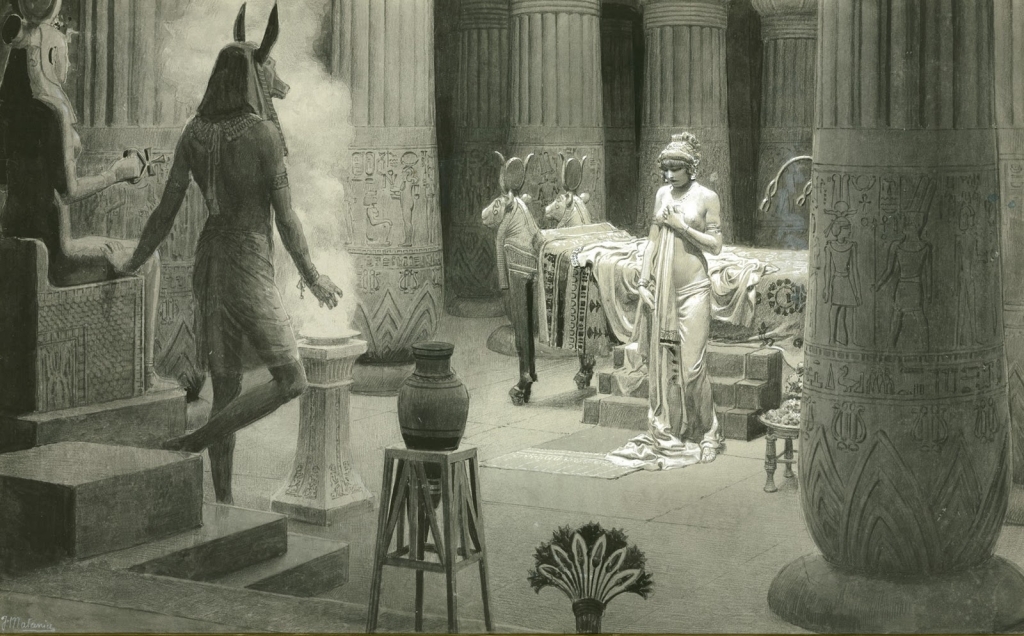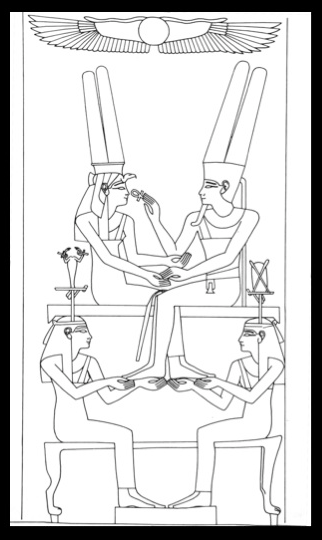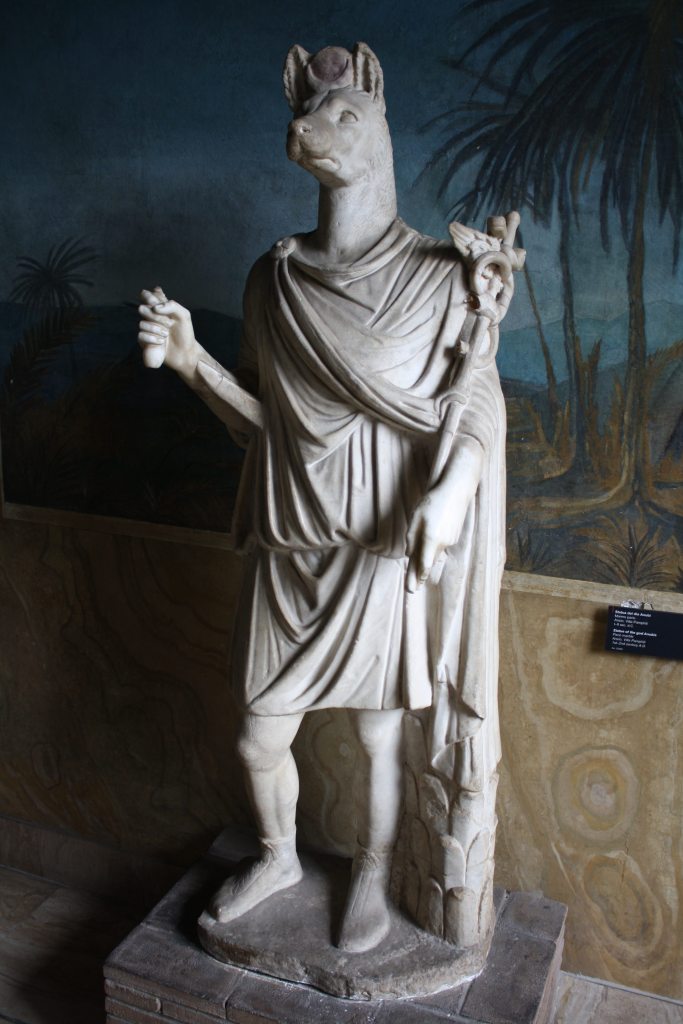Have you heard the shocking—shocking, I tell you!—tale of Paulina and Decius in the Roman Temple of Isis? No? Well, then, as a well-educated Isiac you must, you must. And I’m just the gossip to tell it to you. Here’s the tale, then I’ll join you on the other side for some discussion…
In Rome, in the 1st century CE, there lived a young, beautiful, and rich Roman matron of high birth named Paulina. She was modest, of a most virtuous reputation, and completely faithful to her husband, Saturninus. He, too, was noble and of the very highest character, in every way the equal of his wife. Everybody loved Paulina and Saturninus.

Paulina with pseudo-Anubis on the prowl; this art is by Fortunino Matania (1881-1963), Paulina in the Temple of Isis.
But now, another man enters the scene to disrupt this ideal couple. Of high equestrian rank—we could call him a knight, he “fell in love” with Paulina. I put that in quotes because it was more like “powerfully lusted after,” as we shall see. His name was Decius Mundus and he simply had to have her. He sent gifts. Paulina returned them. He sent more gifts. She returned those, too. Finally—and who knows why he thought this was the way to go—he offered her the outrageous sum of 200,000 Attic drachmae for one night with her.
Predictably, she turned him down.
Drama queen that he was, Decius decided to starve himself to death for want of Paulina. Apparently, he talked about it endlessly.
One of Decius’ servants, a freed woman named Ide, devised a plot that she proposed to Decius. For a mere 50,000 drachmae, she was sure she could get Decius the woman he so histrionically desired. You see, Ide happened to know that Paulina was a devotee of Isis. While lavish gifts and money were not the way to her bed, perhaps religion was.
Ide went to the Temple of Isis and bribed a couple of priests; 25k drachmae now, 25k when Decius succeeds. They agreed and immediately sent one of their number to Paulina. He told her Anubis had given him a message that He was in love with Paulina and wanted to dine and sleep with her. Paulina was flattered. She immediately told Saturninus what Anubis wanted. Apparently he was cool with it, too, so off Paulina went to the Temple of Isis.
Paulina was duly wined and dined without seeing pseudo-Anubis. Then the priests closed the temple and conducted Paulina to the sanctuary, where the lights were put out. Decius leaped out and under the cover of darkness had his way with Paulina. All. Night. Long.
She, rather pleased with the divine experience, went home and proudly told her husband and girlfriends all about it. Her girls were a bit skeptical given the nature of the thing. But since Paulina’s reputation was so immaculate, in the end, they had to believe her.
Three days later, Decius finds Paulina and, sneering at her, admits the whole plot and proves himself to be entirely the asshole we always knew he was. Paulina is pissed. She enlists her husband’s help and he goes straight to Emperor Tiberius. Tiberius has the matter investigated. Eventually the guilty priests and Ide are crucified. The Temple of Isis is razed to the ground. Isis’ sacred image is tossed into the Tiber. And Decius? Merely banished. It was a crime of passion, after all.

Well.
As you can see, this story has almost nothing to do with Isis, except for the venue, some lowlife priests, and, of course, Paulina’s devotion. Aside from its tragicomic-erotic nature, the Paulina story is famous mostly because of the entry right before it in a particular book. The book is Antiquities of the Jews by Flavius Josephus. Josephus’ book is held up as an early source for a historical mention of a certain Jesus, the Christ. (Josephus was ostensibly writing history, so it’s an important mention.) Naturally, there is controversy over whether this is an authentic historical record of Jesus or a later addition by zealous Christians.
Interestingly, the same has been said about the Paulina story. Some have called it a fabrication by Josephus to explain the real persecution of the Jews and the Isiacs by Tiberius in 19 CE. Others say that the gullibility of both Paulina and Saturninus seems more like the plot of a farce than reality. And indeed, there are several similar fictional tales. In the Roman playwright Plautus’ play Amphitryon, Jupiter is sleeping with Amphytryon’s wife, Alcmena, in the guise of her husband. A tricksy slave—who is really Mercury in disguise—confuses things in support of Jupiter’s lustful cause. After some romantic comedy twists, all is well and Amphytryon is okay with sharing his wife with a God.
Then there is the Alexander Romance, which is a highly fictionalized biography of Alexander the Great. Though we mostly know it from Medieval texts, the original has been dated by experts to anywhere from the 3rd century BCE to the 4th century CE. In this story, the Egyptian pharaoh, Nectanebo (both Nectanebo I and II were builders of Isis’ temple at Philae), is also a mighty magician. Basically, he seduces Alexander the Great’s mother, Olympias, by magic, convincing her that she is sleeping with the God Ammon (Amun). Hence the tale that Alexander is a true Egyptian pharaoh by virtue of his Divine father.
It seems likely that the expulsion of the Jews and the Isiacs in 19 CE (as well as other times in Roman history) was more of a political move than retribution for offenses against a Roman matron. During times of internal turmoil, the emperors would stir up the Romans against outsiders (foreign religions, oh my!) and then there would be expulsions or restrictions of some kind. A juicy sex scandal could be the perfect excuse. (For a broader look at Isis in Rome, go here.) On the other hand, it should be noted that Isis devotees in Rome were more known for their religious abstention from sex during periods known as the Chastity of Isis, and not for their licentiousness.
But let’s get back to our sex scandal…
As most of you know, in Egyptian tradition, one did not have temple sex, sacred or otherwise. On the other hand, Egyptian queens did have sex with Gods to produce future kings; it was part of the royal lore. Hatshepsut claimed Amun as her father, the God having come to her mother Ahmose in the form, no doubt, of her father Thutmose I. And Greek and Roman tales have plenty of Divine-human sexual encounters. Hercules is the result of the lovemaking of Jupiter and Alcmene in the play mentioned above.
I’m reading a paper by a scholar, David Klotz, who thinks that sex with Deities may have indeed been going on in temples of the Egyptian Deities during the Roman period. He starts his argument with a tomb painting from El-Salamuni, near Akhmim. Akhmim was known as Koptos to the Greeks. El-Salamuni has a rockcut chapel to Min. Isis and Min were worshipped together at Koptos. As you may recall, Min is the God with the very upright phallus.
So that I do not leave you in suspense, have a look at the tomb painting here. You should be able to click for a larger image. Based on other representations of Anubis in the tomb, they think the naked fellow with the woman on the couch is Anubis as well. Frankly, I can’t quite tell because the head is so destroyed. You?
Klotz mentions that jackals had a reputation for randyness and that an Egyptian dream manual counts it a good omen if a man dreams of his wife having sex with a jackal. In one of the many papyri found in the Oxyrhynchus (Egypt) cache, was an invitation “to dine at the banquet of the Lord Anubis in the oikos [household] of the [probably] Serapeum.” There are also some known stele, funerary in nature, that feature what appear to be dinner and drinking parties taking place with an image of Anubis in the room with the partiers. In some of them, a couple of people are nude or partially nude.
There is also a spell in the magical papyri (PGM) in which the magician first invokes Anubis, then asks Him to bring the local Deities in. Anubis sets up a banquet table for Them, entertaining them until one of the Deities is willing to give an oracle. Anubis is also invoked in some of the non-consensual “love” spells in the magical papyri. At Saqqara, the mudbrick Bes chambers, which featured large images of Bes with smaller images of naked women and in which erotic terracotta votive statues were found, were located in the precinct of Anubis. It is likely that women came there seeking fertility. We don’t know, but it is possible that priests in Godform helped Bes (Anubis?) out in cases like this.
Finally, there are references in Roman literature that connect Anubis with sexy doings. One is the name of a popular farce called The Adulterous Anubis. The other is one of Juvenal’s satiric poems that says priests in the guise of Anubis were the ones who interceded for wives who had not managed to maintain the Chastity of Isis…for a nice bribe, of course.
Klotz concludes that perhaps there was a tradition of priests dressed as Anubis having sex with women in a temple, likely in a quest to conceive a child. So it may be that the fiction of the Paulina story had some kernel of truth—even if the story as a whole does not.
And, you know…maybe. There is a story from the late Pagan period that a couple went to the temple of Isis and actually did come away with a child; a priestess allowed them to adopt her own child. All kinds of propagandistic hay was made over that incident. But it meant that people did continue to come to Isis in a desire for children. And—one way or another—it did happen.









